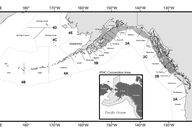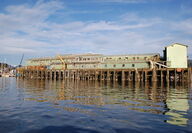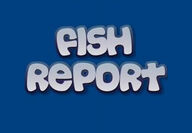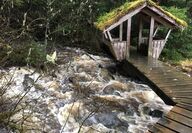Sorted by date Results 101 - 125 of 364
Unexpected upheavals stemming from the coronavirus have slowed the process of getting relief payments into the hands of fishermen and communities hurt by the 2018 Gulf of Alaska cod crash. In late February, the Secretary of Commerce cut loose $24,416,440 for affected stakeholders. Then in late March, Alaska Dept. of Fish and Game Commissioner Doug Vincent-Lang proposed a written timeline for developing a distribution plan and also called for input from communities and fishing groups. A draft of the initial plan was intended to compile...
All systems are go for keeping close tabs on fish and crab stocks in waters managed by the state, meaning out to three miles. While constraints from the coronavirus resulted in nearly all annual stock surveys being cut in deeper waters overseen by the federal government, it’s “closer to normal” closer to shore. “While it’s not business as usual, we are conducting business in as close to normal fashion as we can,” said Forrest Bowers, deputy director of the commercial fisheries division of the Alaska Dept. of Fish and Game. “We have kept all...

Surveys of Alaska's fish, crab and halibut stocks in the Bering Sea have been called off or reduced due to constraints and dangers posed by the coronavirus. In what they called an "unprecedented" move, NOAA Fisheries announced in late May that five Alaska surveys will be cancelled this summer "due to the uncertainties created by the COVID-19 pandemic, and the unique challenges those are creating for the agency." NOAA said in a statement that they found "no way to move forward with a survey plan...

Ocean Beauty Seafoods LLC and Icicle Seafoods, Inc. will be merging their wild salmon and Gulf of Alaska groundfish operations effective June 1, the two companies announced in a joint-statement on Friday, May 29. Both companies will each own a 50 percent stake in the new company, which will be called OBI Seafoods LLC. The company looks to modernize processing facilities and combine marketing product expertise. The merger has been in the works since the fall of 2018, said Mark Palmer, president a...

Ocean Beauty Seafoods LLC and Icicle Seafoods, Inc. will be merging their wild salmon and Gulf of Alaska groundfish operations effective June 1, the two companies announced in a joint-statement on Friday, May 29. Both companies will each own a 50 percent stake in the new company, which will be called OBI Seafoods LLC. The company looks to modernize processing facilities and combine marketing product expertise. The merger has been in the works since the fall of 2018, said Mark Palmer, president a... Full story
Sales of Alaska’s most popular seafoods are being hit hard by markets upended by the coronavirus, but perhaps none is getting battered worse than halibut. Along with the big losses in the lucrative restaurant trade, Pacific halibut also is facing headwinds from increasing foreign imports. Starting three years ago, sales of fresh Pacific halibut to established markets on the east coast were toppled by a flood of less expensive fish flowing in primarily from eastern Canada. Trade data show that for 2019 through February 2020, total Canadian h...
The value of Alaska salmon permits is another casualty of the coronavirus with prices dropping for all fisheries across the state. There are a lot of permits for sale - and the most offers ever to lease permits, especially at Bristol Bay. The virus has changed everything, said Doug Bowen of Alaska Boats and Permits in Homer. “There’s so much uncertainty about if there will even be a salmon season here and there, and if so, what kind of a price can be expected and so on. I can’t think of one salmon permit that is going up in value. And if there...
Alaska’s total salmon catch for 2020 is projected to be down 36 percent from last year’s haul of 207 million fish, the eighth largest on record that was valued at nearly $658 million at the docks. In the Run Forecasts and Harvest Projections and Review of the 2019 Season just released by the Alaska Dept. of Fish and Game, managers are calling for a harvest of just under 133 million salmon across Alaska. The decline is driven by a much lower forecast for those hard to predict pink salmon of just over 60 million fish, down nearly 53 percent. Her...
How can fishermen be sure their vessels are clean of coronavirus contamination? Where can they find out about relief funds that are newly available for fishermen? COVID-19 has Alaska’s seafood industry traveling in uncharted waters as more fisheries continue and get underway, and fishermen and processors prepare for a salmon season that’s just a month away. Information in an upside down world changes daily, making it tough to plot a course. United Fishermen of Alaska has crafted a “one stop shop” for the latest fishing-related COVID-19 updates...
The State of Alaska wants input on plans to distribute nearly $24.5 million in federal disaster relief funds for stakeholders and communities hurt by the 2018 Gulf of Alaska cod crash. Better make it quick – the deadline to comment is April 10. Cod is Alaska’s second largest groundfish harvest (after pollock), but the Gulf stock dropped by 80% in 2018 following a three year heatwave that disrupted food webs, fish metabolism and egg survival on the ocean floor. It combined to push down cod catches to just 28.8 million pounds, compared to nea...
The Pacific halibut fishery opened on March 14 amid little fanfare and flattened markets. The first fish of the eight month season typically attracts the highest prices and is rushed fresh to high-end buyers, especially during the Lenten season. But that’s not the case in this time of coronavirus chaos, when air traffic is stalled and seafood of all kinds is getting backlogged in global freezers. Alaska’s share of the 2020 halibut catch is about 17 million pounds for nearly 2,000 fishermen who own shares of the popular flatfish. A week int...
KODIAK, Alaska (AP) — Shoppers will no longer see a blue-sticker label on Gulf of Alaska cod after its sustainability certification is suspended starting in April. The label designates which fish are sustainably caught. Alaska’s Energy Desk reported Friday that the Marine Stewardship Council, which sets standards for sustainable fishing, will suspend the label starting April 5. “What the MSC certification really does is along the supply chain it allows for there to be traceability,’’ council spokeswoman Jackie Marks previously told Alaska’s...

Alaska shellfish farmers and divers fear they won't be 'open for business' much longer if they're forced to pick up the tab for federally required lab tests as outlined in Governor Dunleavy's budget. The Department of Environmental Conservation (DEC) has proposed shifting the state cost to the harvesters which last year totaled almost a half million dollars. Geoduck clam divers in Southeast Alaska, for example, pay about $150,000 each year to collect samples that are sent to the single...
Alaska lawmakers are making fast work of several fish bills that have wide support from Alaska’s fishermen. “I was anticipating a somewhat slow start, but they’re organized and they’re diving right into these issues and taking these bills up. And so there’s lots of opportunities to participate,” said Frances Leach, executive director of United Fishermen of Alaska. The bill (HB 35) that would resolve a conflict of interest fix at the state Board of Fisheries has been moving through committee hearings in Juneau and could finally be settled aft...
It’s been a long time coming but payments should soon be in hand for Alaska fishermen, processors and coastal communities hurt by the 2016 pink salmon run failure, the worst in 40 years. The funds are earmarked for Kodiak, Prince William Sound, Chignik, Lower Cook Inlet, South Alaska Peninsula, Southeast Alaska and Yakutat. Congress ok’d over $56 million in federal relief in 2017, but the authorization to cut the money loose languished on NOAA desks in DC for over two years. The payouts got delayed again last October when salmon permit hol...

Alaskans saw salmon die offs last summer across the state when water temperatures soared into the mid-70s to above 80 degrees in some regions. But what about threats to salmon from the accompanying global gorilla - increased acidity? It’s a shock to learn that while extensive studies for years have been underway by Alaska scientists on impacts to major fish and shellfish stocks, there’s been none done in Alaska for salmon. In fact, only two lab studies have been done on Alaska salmon, both out o...
Every year since 1991 Fish Factor has selected “picks and pans” for Alaska’s seafood industry - a no-holds-barred look back at some of the year’s best and worst fishing highlights, and my choice for the biggest fish story of the year. Here are the 2019 picks and pans, in no particular order - Best fish scientist – Dr. Bob Foy, director of science and research at NOAA’s Alaska Fisheries Science Center/Juneau – No one explains science better or with more passion. Biggest new business potential: Mariculture. Alaska is acting on plans to grow a $10...
Alaska’s seafood industry will be “open for business” starting January 1 when some of the biggest fisheries get underway long before the start of the first salmon runs in mid-May. Cod will begin it all in the Bering Sea, which has a 305.5 million pound catch quota, down about a million pounds from 2019. Less than 6 million pounds of codfish will come out of the Gulf. A 400,000 Tanner crab fishery at Kodiak starting on January 15 will be helpful to a town whose economic bottom line will be badly battered by the Gulf cod crash. But it will be th...
They say good things come in small packages and that’s the case for Alaska cod fishermen heading into the new year. A small cod fishery will occur in Gulf state waters (out to three miles) for 2020, putting to rest speculation that no cod would be coming out of the Gulf next year. A catch quota of about 5.6 million pounds, down from 10.2 million pounds, will be split among five regions: Prince William Sound, Cook Inlet, Kodiak, Chignik and the South Alaska Peninsula, with limitations on gear and staggered openers. That will be a relief to thous...
Lower catches for Pacific halibut are in the forecast for the foreseeable future. That was the message from the International Pacific Halibut Commission at its meeting last week in Seattle. The IPHC oversees halibut stock research and sets catch limits for nine fishing regions ranging from Northern California and British Columbia to the Bering Sea. There are fewer of the prized flatfish (down 4%), they weigh less (down 5%) and no big pulses appear to be coming into the stock was the grim and the results of summer long surveys at nearly 1,370...
The value of Alaska salmon permits has ticked upwards in regions that experienced a good fishery this year while others have tanked. Not surprisingly, the record sockeye fishery at Bristol Bay has boosted sales of driftnet permits to nearly $200,000, up from the mid-$170,000 range prior to the 2019 season. Another strong run forecast of 48.9 million sockeyes for 2020 with a projected harvest of 36.9 million could increase the value even more, said Doug Bowen of Alaska Boats and Permits in Homer. What’s really raising eyebrows, Bowen said, is v...

The heavy rainfall this month has been pushing precipitation levels closer to the normal 109.23 inches of rain that normally falls in Petersburg each year, according to Wes Adkins, a meteorologist with the National Weather Service in Juneau. The total amount of rainfall this year in Petersburg is at 82.30 inches, as of Nov. 15. Over the weekend, precipitation levels surpassed the normal 12.22 inches for the month of November. The Climate Prediction Center forecasts a tilt towards higher than...
Alaska’s 2019 salmon season was worth $657.6 million to fishermen, a 10% increase from the 2018 fishery. Sockeye salmon accounted for nearly 64% of the total value, topping $421 million, and 27% of the harvest at 55.2 million fish. Those are the lead takeaways in a summary from the Alaska Department of Fish and Game that reveals preliminary estimates of salmon harvests and values by region. The final values will be determined in 2020 after processors, buyers, and direct marketers submit their totals paid to fishermen. Pink salmon were the s...
ANCHORAGE, Alaska (AP) — Nearly $150 million was spent on mineral exploration for primarily large mine opportunities in Alaska last year, officials said. That figure is up from just more than $50 million in spending three and four years ago, The Alaska Journal of Commerce reported Wednesday. Mineral exploration spending reached a peak of $350 million per year in the late 2000s, according to the Alaska Department of Natural Resources. There were 18 large exploration projects across the state for “every metal under the sun,” said Curt Freem...
The federal government’s plan to raze more roads through the Tongass National Forest is facing strong headwinds from fishermen, Native groups and coastal communities throughout Southeast Alaska. Over 220 Southeast Alaskan fishermen signed a letter to the Trump Administration last week opposing the abrupt push to exempt the Tongass National Forest from a roadless rule in place for over a decade. The exemption would release more than 9 million acres from protection and open nearly 200,000 acres to logging. The U.S. Forest Service made the a...